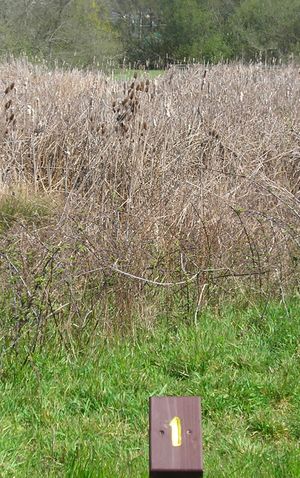Butcher's Slough[edit | edit source]

Along this trail visitors will see a variety of different wildlife, vegetation, and development. Through out this trail there are signs 1-13, below are what the following numbers correspond to.
1) This wetland is created by fresh water being pumped into the pond from the wells that were also used by old lumber mills in the 1940's.
2) This marsh was once used to store logs to be cut into lumber for the local mills. This pond received an extensive cleaning after all the local mills were shut down because of the disappearing lumber market.
3) This is the actual creek Butcher's Slough that forms Butcher's Slough Marsh. A variety of Egrets can be seen from this spot.
4) This spot corresponds to the different plant zonation in salt water. Different zonation in plants is due to the different salt content in each elevation of the marsh. Each plant has a different tolerance to the salt concentration in the marsh which leads to the visible different locations of the plants.
5) This is a great spot to bird watch.
6) In this spot Cordgrass (Spartina densiflora) and Pickleweed ( Salicornia sp.) can be seen, which are two plants that can sustain life with very high concentration of salt in there environment.
7) This concrete structure is a very interesting fish ladder. This structure maintains mostly the water levels in the pond. It does not serve as a fish ladder because the pond does not contain enough dissolved oxygen. This is a great spot to see the wildlife of the Arcata Marsh and Wildlife Sanctuary.
8) This is the site of the restoration that was done in 1985.
9) This is a great place to here the sounds of the Arcata Marsh and Wildlife Sanctuary, everything from plants to frogs.
10) This spot corresponds to the fresh water plant zonation. Fresh water plant zonation is determined by water depth.
11) This site shows the public the plant Marsh Pennywort (Hydrocotyle ranunculoides a mat former) which overgrows the pond and has to be cut back each year so other plants can grow also.
12) This site has a huge concrete "bunker" that was used for logging operations.
13) This trail has been maintained and is preserved by the restoration work that was done to the degraded wetlands during the logging industry.[1]
References[edit | edit source]
- ↑ Branch, Susan. Homer, Denise. Butcher's Slough Self Guided Trail.(2000) Retrieved on April 20, 2008 from the Arcata Marsh and Wildlife Sanctuary Interpretive Center